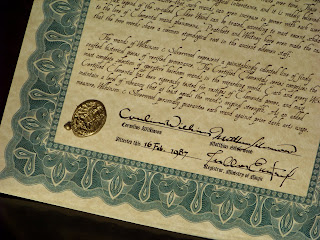But I am being haunted by the Mysterious Blue Screen of Death.
A couple of weeks ago, we were unpacking some more moving boxes and I found a treasure trove of interesting supplies. I snapped some pictures and am uploading them (unedited) via the back computer. I have thus won one small victory over the Terrible Blue Screen of Death.
This is what we found:
Mom actually got it at a garage sale a few years ago.
It's engineering drafting tools. You know, from those dark ages before computers. Or at least before computers that could do design work.
This is the same sort of stuff that my parents used in high school and college.
Weird. :)
Apparently engineers had to be artists. Just look at this glorious collection of pencils! Sharpened to an inch tall... these are well loved pencils with lots of history.
And just look at that pencil tin! I wish that artist pencils were still sold in tins rather than cardboard and plastic.
There is also a really bizzare pencil in the mix. Mom calls it an old style of mechanical pencil. It is a wooden pencil with an interesting, albeit broken, mechanism in the hollow part.
This is when I got really excited. Old watercolors... sandpaper stacks for sharpening pencils... an interesting bottle of ink (with the labeling all auf Deutsch, in German), a horsehair brush, and a strange pillow of white sandy stuff.
The sandpaper is going to be super useful, and I was excited to find the horsehair brush. It is good for brushing eraser bits off of drawings without smearing pencil lines.
Mom says that the interesting pillow thing with white sandy stuff is used in a similar way: you rub it onto your drafting work to keep the graphite on and other things off. I don't get it, though. Why would you want to get white sandy stuff all over your artwork drafting work?
Rulers and a huge assortment of thingamabobs. I know what those thingamabobs are called. Honestly, I do! Mom and Dad have many old ones that we kids love to play with.
The word is on the tip of my tounge, but is playing hide and seek with my brain.
I do know what they are called.
Here are a few of the more interesting thingamabobs. The only one I recognize is the well-loved French Curve. The top thingamabob is all swirly and pretty. Me likey.
The middle thingamabob is a lettering guide. It had instructions taped onto it: they are very confusing. o.O It makes me glad that I have Photoshop (well, I would have a working Photoshop if I weren't haunted by the Blue Screen of Death)-- if I want to add lettering to anything, I can just type it in and move the text wherever I want.
However, I'm going to learn how to use the confusing-looking-lettering-guide. It might prove to be useful for calligraphy! (The real calligraphy. The kind that doesn't use a computer.)
(Ha. Take THAT, Mr. Evil Blue Screen of Death. I have thwarted your plans. I have posted on my blog. A quick and rambling and mildly uninteresting post, but a post nonetheless.)


























































